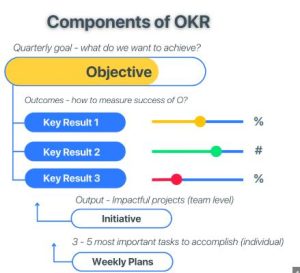How to Write a Good OKR: What Are the Steps?
Objective and Key Results (OKRs) have become a vital tool in setting ambitious goals and tracking progress within organizations, ranging from startups to Fortune 500 companies. Crafting effective OKRs is both an art and a science, involving clear communication, strategic thinking, and measurable benchmarks. Here's a practical guide on how to structure your OKRs to maximize their impact and drive your team to excel.

Clarify Your Objective
Your objective should serve as a rallying point for your team. It needs to be bold and clear. An ideal objective isn't just a statement of routine operations but a declaration of a desired future. For instance, if a company aims to dominate the regional market, a suitable objective could be "Become the top service provider in the Northeast by Q4." Notice how this isn't just a wish but a specific, actionable statement.
Determine Measurable Key Results
Key results are the backbone of an effective OKR. They should clearly measure how you will accomplish the objective. These aren't tasks or activities, but quantifiable outcomes. For example, increasing customer retention from 70% to 85% by year-end or boosting production efficiency by 20% in six months are quantifiable targets that provide clear direction and allow precise progress tracking.
Set Up a Timeline
Timing is crucial for motivation and momentum. Without a defined timeline, even the most well-intentioned goals can drift into the realm of "someday." A 90-day frame is typical for OKRs as it's long enough to see meaningful results but short enough to keep everyone engaged. This period aligns well with quarterly business cycles, allowing for adjustments and recalibration as needed.
Align OKRs with Overall Business Goals
For OKRs to truly be effective, they must align with the broader business strategies. This ensures that every team's efforts contribute directly to the company's success. If a business's annual goal is to increase market share, departmental OKRs should directly support this aim, whether through innovation, customer satisfaction, or operational efficiency.
Engage and Empower Your Team
The best OKRs come from not just top-down mandates but from collaborative efforts. Engage your team in the OKR setting process to leverage their insights and secure their buy-in. When team members contribute to goal setting, they are more committed and more likely to push for success. This approach also helps to identify potential challenges and innovative solutions early in the process.
Review and Refine Regularly
Constant evaluation is key to OKR success. This isn't about micromanaging but about monitoring progress and making adjustments as necessary. Monthly check-ins are ideal to ensure that OKRs remain relevant and teams stay on track. These reviews should encourage open dialogue about what's working, what isn't, and what might need to change.
Instill Accountability
Each OKR should have a directly responsible individual. Accountability ensures that OKRs don't fall through the cracks. When someone knows they will report on an OKR's progress, they're more likely to prioritize it and strive for excellence.
Drive Results with Effective OKRs
Writing effective OKRs is crucial for setting your team up for success. They clarify what needs to be done, provide a measurable way to gauge success, and align daily efforts with longer-term goals. The power of a well-written OKR lies in its ability to inspire and challenge a team to achieve more.
For more details on how to write a good OKR, check out comprehensive strategies that can help guide you through each step of the process.